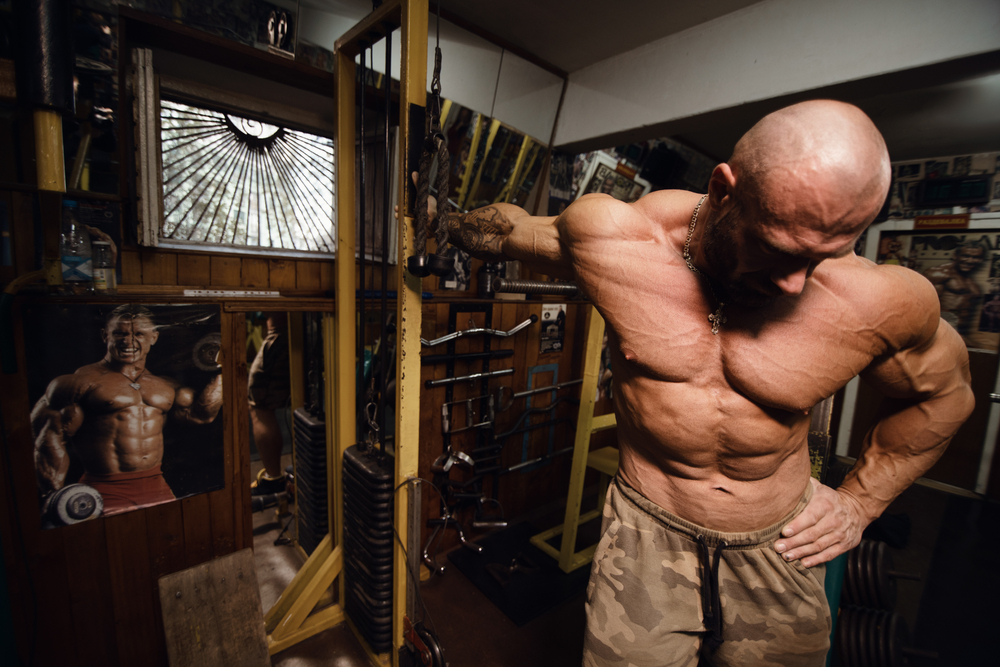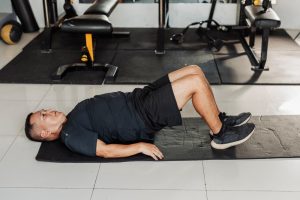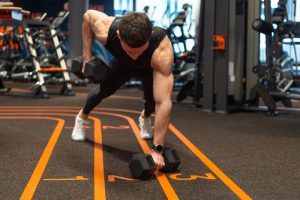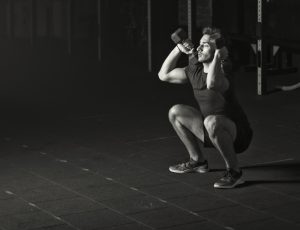The five best biceps stretches are the standing biceps stretch with hands clasped behind your back, the seated biceps stretch, the doorway biceps stretch, the wall biceps stretch, and the elbow hang stretch.
These proven techniques target different parts of your biceps while accommodating various fitness levels and mobility needs.
Keep reading for detailed step-by-step instructions, proper form techniques, and essential safety guidelines to help you perform each stretch effectively and avoid common mistakes.
Standing Biceps Stretch (Hand Clasp Behind Back)
This stretch stands out because it works two muscle groups at once, targeting your biceps and chest muscles in a single movement.
You can easily control how intense the stretch feels, making it perfect whether you're just starting out or have been stretching for years.
Start by standing with your feet shoulder-width apart and keep your head in a neutral position.
Reach behind your back and interlace your fingers together at the base of your spine.
Once your hands are clasped, press your shoulders down and draw your shoulder blades together.
Now straighten your arms and slowly lift them away from your body.
You should feel a gentle stretch sensation through your biceps and chest area, but never any pain or sharp discomfort.
Hold this position for up to one minute, then relax and repeat the stretch one to three times for the best results.
If you can't quite get your hands to meet behind your back, don't worry – simply use a towel to bridge the gap between your hands.
For a different angle on the stretch, try the same movement but point your thumbs down toward the floor instead.
This small change shifts which part of your biceps gets the most attention.
Seated Biceps Stretch
The seated position gives you a major advantage over standing stretches – you can control exactly how intense the stretch feels while keeping your whole body anchored.
This stability lets you really zero in on your biceps muscles without worrying about balance or compensating with other muscle groups.
Setting up your position:
- Sit with your knees bent and feet flat on the floor in front of your hips
- Place your hands on the floor behind you with fingers pointing away from your body
- Distribute your weight evenly between your feet, buttocks, and arms for solid stability
Once you're in position, the magic happens when you slowly scoot your buttocks forward toward your feet.
Keep your hands planted exactly where they are – don't let them slide or shift.
This creates the stretch by changing the angle at your shoulders and elbows while your arms stay locked in place.
Hold this position for up to 30 seconds, then return to your starting position and relax.
Repeat the stretch two to four times, and here's where the real progression comes in: between each repetition, slide your buttocks slightly further forward.
This gradually increases the stretch intensity as your muscles warm up and become more flexible.
Safety is straightforward but important – keep all your movements controlled and smooth.
If you feel any pain in your wrists or shoulders (not just the stretch sensation in your biceps), back off immediately.
The stretch should feel like gentle tension through your biceps, never sharp or uncomfortable in your joints.
Doorway Biceps Stretch
This stretch hits the biceps more completely than most others because your bicep muscle crosses both your elbow and shoulder joints.
The doorway position opens up this entire area in one smooth movement, giving you a comprehensive stretch that targets the full length of the muscle.
Getting into position:
- Stand in a doorway with your elbows bent and each forearm resting against one side of the doorframe
- Position your elbows at about chest height for optimal angle
- Keep your forearms firmly planted against the frame throughout the stretch
The movement itself is simple but effective.
Step one foot through the doorway and move your hips and chest forward while your forearms stay exactly where they are.
This creates the stretch by pulling your body away from your anchored arms.
Focus on creating length through both your chest and arms rather than just pushing forward.
Keep your shoulder blades in proper position – don't let them wing out or collapse inward.
You should feel the stretch flowing from your biceps through your chest and front shoulders.
Hold this position for up to 30 seconds, then repeat on the other side if you're stretching one arm at a time.
Between each repetition, move your hips and chest back to relax out of the stretch completely.
This recovery pause prevents you from overstretching and lets your muscles reset before the next round.
Watch out for these common mistakes: letting your shoulders hunch forward ruins the stretch's effectiveness, and forcing the movement beyond your comfort level can strain your shoulders or chest.
The stretch should feel substantial but never painful or forced.
Wall Biceps Stretch
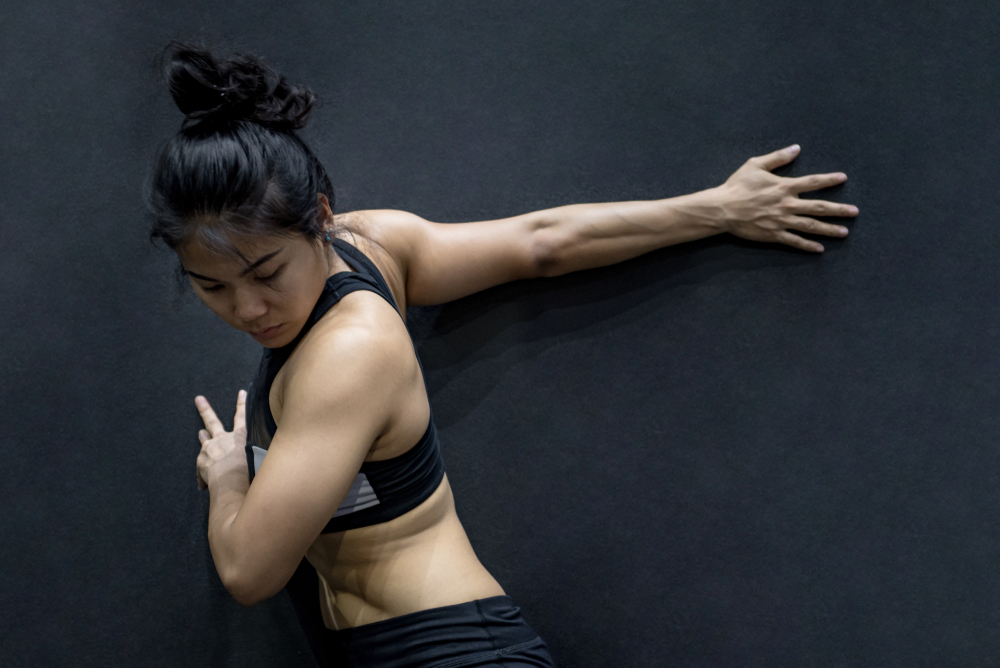
What makes this stretch unique is how you can target different parts of your biceps muscles just by changing your hand position against the wall.
This versatility lets you hit areas that other stretches might miss, giving you more complete biceps flexibility.
Start by standing next to a wall and place your fingers and palm flat against the surface.
If you can't get completely flat contact, get as close as you comfortably can – flexibility improves over time.
Keep your arm straight and parallel to the ground throughout the entire stretch.
This arm position is crucial for targeting the biceps effectively.
The movement sequence:
- Take a large step forward with your opposite leg
- Bend that knee and shift your body weight forward
- Let your body move away from the wall while your hand stays planted
Here's where this stretch gets interesting – add a gentle rocking motion back and forth to continue stretching your biceps throughout the hold.
This dynamic element keeps the muscle engaged and can help you find the sweet spot for the best stretch sensation.
Form checkpoints that matter: Don't let your shoulder hunch up toward your ear, and pay attention to where you feel the stretch.
You should sense it along your upper arm, into your elbow, and possibly even in the front of your wrist.
This tells you the stretch is working through the full length of the biceps.
You control the intensity by adjusting two variables – how far you stand from the wall initially and how much you lean forward during the stretch.
Start conservative and gradually increase both as your flexibility improves.
Elbow Hang Stretch
This is the most gentle biceps stretch you can do because gravity handles most of the work for you.
Instead of fighting against tight muscles, you're letting natural forces slowly coax them into relaxation, making it perfect for when your biceps feel particularly sore or tight from training.
Simple setup requirements:
- Place your elbow on a table or sturdy surface
- Roll up a towel and put it under your elbow for comfort and support
- Make sure you can sit comfortably with good posture
Start with your elbow bent, palm facing toward you, and fingers pointing toward the ceiling.
This is your home position that you'll return to after each repetition.
The movement cycle:
- Slowly straighten your elbow by moving your hand toward the table
- Feel the gentle stretch through your arm muscles as gravity pulls down
- Slowly bend your elbow back to the starting position in a controlled manner
- Repeat this cycle multiple times rather than holding any single position
This stretch works differently than the others – you're performing multiple slow repetitions instead of static holds.
The continuous, gentle movement helps break up muscle tension and promotes blood flow better than holding a single position would.
When this stretch shines: Use it after tough workouts when your biceps feel beaten up, or anytime your arms feel particularly tight from training or daily activities.
The gentle nature makes it ideal for recovery days when you want to maintain mobility without adding stress to already fatigued muscles.
Essential Guidelines for Safe and Effective Biceps Stretching
Getting biceps stretching right isn't just about the stretches themselves – it's about how you prepare, when you do them, and what you're trying to achieve.
Follow these guidelines to maximize your results while staying safe.
Preparation and Timing
Never jump straight into stretching cold muscles.
Complete three to five minutes of light aerobic activity first to increase blood flow to your biceps and surrounding tissues.
This could be arm circles, light jogging in place, or gentle arm swings – anything that gets your blood moving.
Optimal frequency and timing:
- Stretch your biceps at least three times weekly for meaningful improvements
- Include stretches at both the start and end of your workouts
- Pre-workout stretching prepares muscles for activity
- Post-workout stretching aids recovery and prevents tightness
Duration that works: Hold each stretch for 15-30 seconds and repeat for two to four sets.
If you're older, you may need to hold stretches closer to 60 seconds to get the same benefits that younger people achieve in shorter timeframes.
Form Fundamentals and Safety
Listen to your body throughout every stretch – it's your best guide for knowing when to back off and when you can go deeper.
Maintain smooth, steady breathing rather than holding your breath, and never lock your elbows or force any positions.
Stretching should feel like controlled tension, not painful pressure.
Critical mistakes that cause problems:
- Bouncing during stretches prevents your muscles from relaxing and significantly increases your risk of muscle or tendon tears
- Skipping the warm-up period can cause rips or tears when you stretch cold, tight muscles
- Poor positioning makes you miss the target muscle entirely, wasting your time and effort
Benefits That Make It Worth Your Time
Regular biceps stretching delivers benefits that extend far beyond just flexible arms.
You'll prevent injuries like bicep strains and tendonitis while improving your range of motion for both daily activities and exercise performance.
Performance and recovery advantages include:
- Reduced muscle soreness through better lactic acid breakdown and faster recovery
- Enhanced blood circulation that delivers oxygen and nutrients to your muscles
- Better range of motion that lets you activate more muscle during arm exercises, leading to greater strength gains
- Improved posture support since flexible biceps put less stress on your shoulders and enhance overall upper body alignment
The combination of injury prevention, better performance, and faster recovery makes biceps stretching one of the most efficient investments you can make in your fitness routine.
Conclusion
These five biceps stretches give you a complete toolkit for maintaining flexible, healthy arms regardless of your fitness level or available equipment.
Regular practice will help you prevent injuries, improve your range of motion, and enhance your overall arm strength and performance.
Start with the stretches that feel most comfortable to you, focus on proper form over intensity, and gradually work all five into your routine for the best results.

